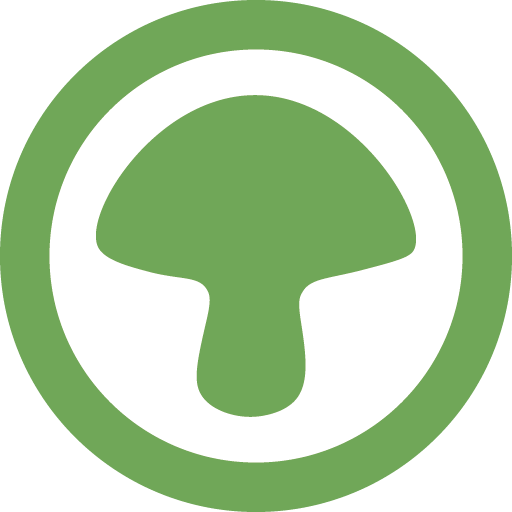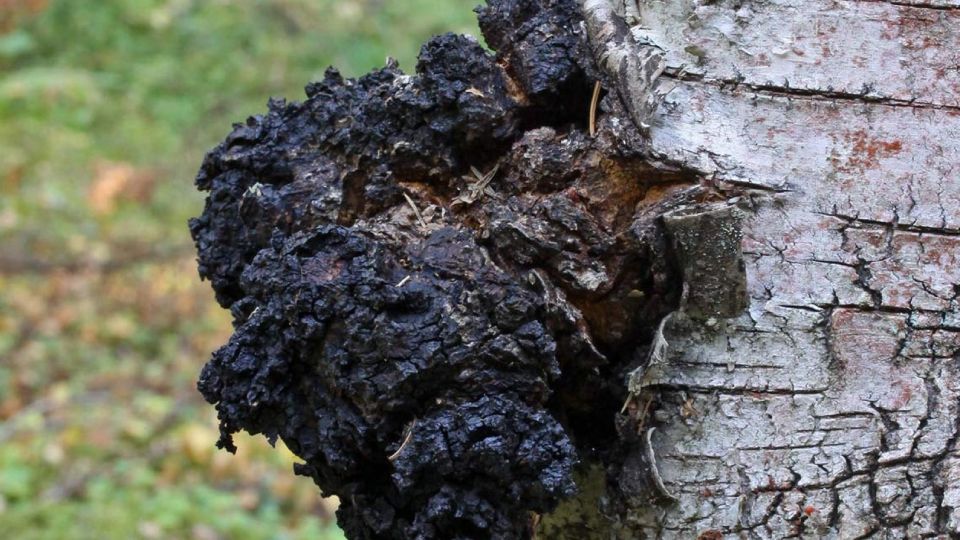What Are The Two Sides of Chaga? Truth Revealed
Chaga, a medicinal mushroom with a long history of use by local populations, has gained immense popularity in natural medicine due to its numerous health benefits. However, it’s important to consider the two sides of the Chaga story: its valuable properties and the pressing concerns related to overharvesting.
For centuries, this mushroom has been treasured for its medicinal properties, making it highly sought after in the natural medicine community. People have found relief from various health issues through its use.
Nevertheless, as its popularity grew, commercial exploitation followed suit, leading to worries about overharvesting. The increased demand for chaga has put a strain on its natural habitat and raised concerns about the sustainability of its population.
In this article, we will delve into the positive aspects of Chaga and its potential health benefits while also addressing the important issue of overharvesting. By exploring both sides, we hope to gain a comprehensive understanding of Chaga and its role in natural medicine. Remember, it’s essential to approach chaga usage responsibly to ensure its preservation for future generations.
In this article:
What Are The Two Sides of Chaga?
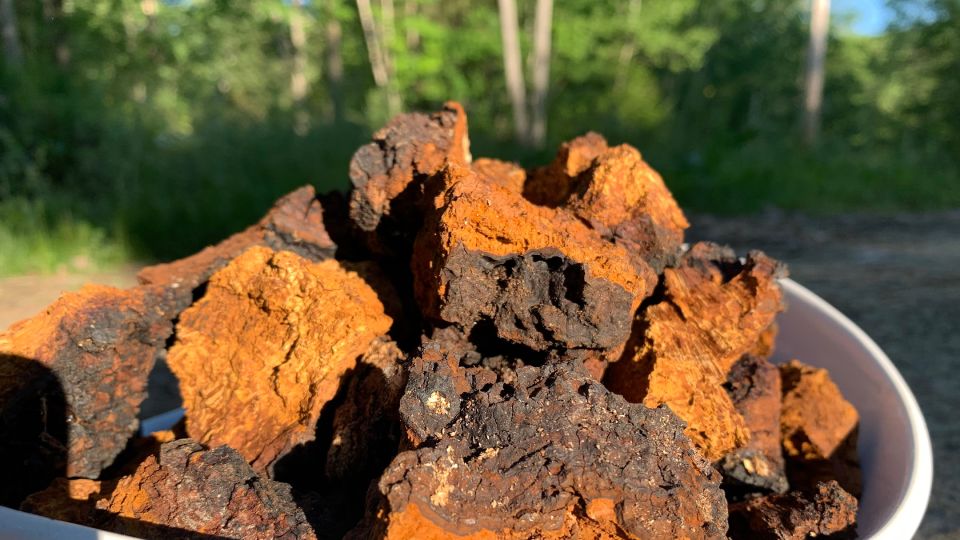
1. The Positive Side of Chaga: The Benefits
Chaga has caught the attention of health enthusiasts worldwide for its potential to boost the immune system, reduce inflammation, and combat oxidative stress. This unique mushroom has been hailed as a superfood, finding its way into various products, such as chaga tea and Chaga mushroom coffee, promising a plethora of health advantages[4].
This mushroom is celebrated for its ability to support heart health by potentially lowering blood pressure and cholesterol levels. Additionally, its antioxidant properties may aid in neutralizing free radicals, thus reducing the risk of chronic diseases like heart disease[5].
Chaga is known to have a high concentration of beta-glucans, compounds that have been studied for their potential to stimulate the immune system, enhancing its ability to defend against infections and illnesses[6].
2. The Other Side of Chaga: The Problem with Overharvesting
While the demand for Chaga continues to grow, the ecosystem it thrives in faces a risk of overharvesting. The popularity of chaga as a medicinal mushroom has led to increased harvesting practices, potentially endangering the survival of this valuable resource.
After completing each life cycle, Chaga mushrooms fall to the ground and release spores. These spores are then spread throughout the boreal forest by wind and animals, finding new host trees.
When harvesting chaga, it’s crucial to consider the mushroom’s stage. If it’s still young and edible, it won’t be able to release spores. To ensure their propagation, leave some chaga mushrooms on the birch trees.
Unfortunately, many foragers, especially amateurs, tend to harvest chaga excessively. Due to its rarity and high value, they take as much as they can find, leading to overharvesting and improper harvesting practices that can harm both the tree and the fungus.
To protect chaga mushrooms and their habitat, adopting responsible harvesting practices and raising awareness about sustainability is essential.
Why is Chaga at Risk of Overharvesting?
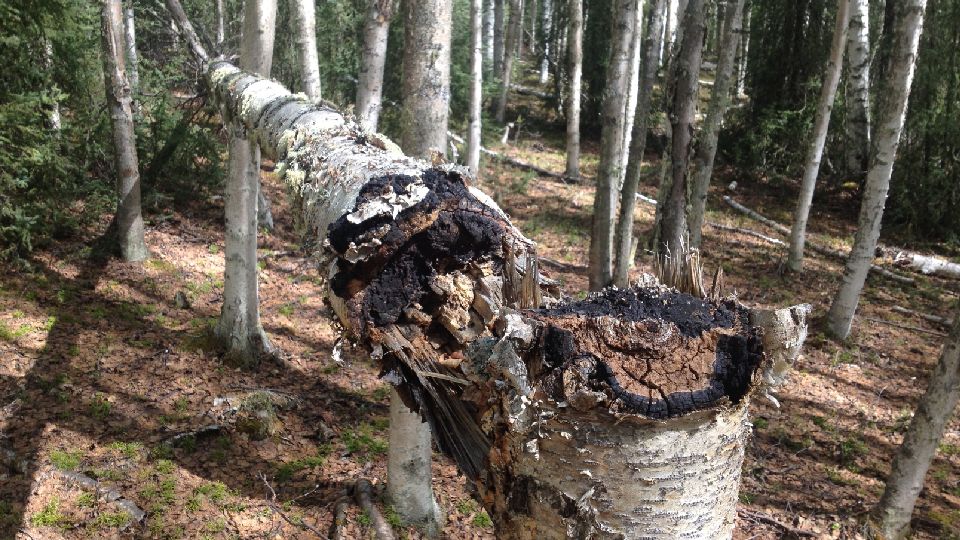
- The increasing popularity of this mushroom has created high demand, putting pressure on harvesters to collect more than the mushroom population can sustainably provide.
- Chaga mushrooms have a slow growth rate, taking up to 20 years to mature. Over-harvesting can deplete the population faster than it can naturally regenerate.
- Chaga thrives in specific regions like Canada, Russia, Siberia, northeast China, and northern parts of the United States. Its limited habitat makes it challenging to find new sources once local populations are depleted.
- The lack of regulation in the mushroom foraging and chaga supplement industries can lead to unsustainable harvesting practices and poor quality control.
To protect Chaga from over-harvesting, it’s crucial to promote sustainable practices, raise awareness about responsible harvesting, and advocate for proper regulation within the industry.
What is Chaga?
Chaga, scientifically known as Inonotus obliquus, is a parasitic fungus that mainly grows on birch trees. It is known as one of the healthiest fungi globally and has gained significant popularity in alternative medicine over the past decade. Chaga thrives in cooler climates and is mainly found in northern Europe, Asia, and North America.
Despite its unusual appearance, It has a long history of use in traditional medicine for its potential health benefits. People highly value its antioxidant properties and often consume it as tea or in extract form.
It is believed to support immune function, promote overall well-being, and potentially offer anti-aging, and anti-inflammatory effects. As a natural health supplement, it continues to gain popularity, captivating the interest of both researchers and health enthusiasts alike.
The Benefits of Chaga
Chaga mushrooms offer an array of health benefits. For instance, a study on diabetic mice revealed that Inonotus obliquus may assist in diabetes management by lowering blood sugar levels[1].
Moreover, this medicinal mushroom has cholesterol-lowering properties, strengthens the immune system, and promotes healthy hair and skin[2].
In the fight against cancer, Chaga shows promising potential by slowing down the spread of cancer cells and aiding in their destruction[3].
Some of the most notable potential health benefits of Chaga mushrooms include:
- Lowering inflammation
- Supporting physical endurance
- Potentially combating certain cancers
- Providing antioxidants and nutrients
- Treating skin issues
- Lowering blood pressure
- Help with stress
- Relieving sleep disorders
Medical Compounds Found in Chaga
| Medical Compound | Benefits |
| Beta-Glucans | Enhance the immune system and may have anti-cancer effects |
| Betulinic Acid | Exhibits anti-tumor and anti-inflammatory properties |
| Melanin | Functions as a potent antioxidant |
| Polysaccharides | Support immune system health |
| Sterols | It may help regulate cholesterol levels |
Potential Side Effects
As we delve into the two sides of Chaga, let’s examine the side effects linked to Chaga’s use. While chaga is generally considered safe for most people, it is crucial to be aware of possible interactions with certain medications. If you are taking prescription drugs, it is best to consult a healthcare professional before incorporating chaga into your routine.
Some people may experience allergic reactions to chaga, which could range from mild skin irritation to more severe symptoms. To avoid adverse reactions, it is essential to start with small amounts and gradually increase the dosage, observing any changes in your body’s response. Pregnant women should avoid using Chaga due to potential risks.
Here are other potential side effects associated with Chaga:
- Digestive Issues: Chaga consumption can cause digestive discomfort in some cases, such as upset stomach, diarrhea, or constipation. Start with a small dose and monitor your body’s response.
- Lowered Blood Sugar Levels: Chaga may lower blood sugar levels. If you have diabetes or take medications for blood sugar control, monitor your levels closely to avoid hypoglycemia (low blood sugar).
- Potential Toxicity: While rare, isolated reports exist of Chaga from contaminated sources containing toxic substances. Get Chaga from reputable sources to minimize the risk of contamination.
The Science Behind The Concerns
Amid the enthusiasm for the health benefits of chaga lies a growing ethical concern regarding its harvesting. The increased demand has prompted unethical practices, such as over-harvesting and harming the delicate balance of the ecosystem in which chaga grows.
Whether you’re interested in harvesting chaga or using it for its health benefits, it’s essential to consider how we can prevent further overharvesting of this valuable fungus.
Foragers can take steps to protect it and the birch trees during harvesting. Learn about safeguarding techniques and how to distinguish chaga from similar sterile conks to avoid unnecessary harm.
Consumers who don’t forage can also play a part in preventing overharvesting. When purchasing chaga supplements, powders, teas, or chaga-infused foods, make sure to support companies that ethically source their mushrooms. This way, we can all contribute to the preservation of this precious resource.
Current Studies and Research About The Two Sides of Chaga
Researchers have been working tirelessly to uncover more about the potential health benefits of chaga. Ongoing studies focus on its effects on various health conditions, including cancer, diabetes, and immune system disorders[7]. Some studies have explored the possible synergistic effects of combining chaga with other medicinal mushrooms like reishi and lion’s mane.
Studies have suggested that Chaga mushrooms might help lower blood sugar levels. For instance, some research has shown that the compounds in Chaga inhibit the enzyme alpha-glucosidase, which breaks down carbs in the small intestine. By inhibiting this enzyme, Chaga could potentially slow the absorption of sugar into the bloodstream[8].
Furthermore, while some research results are promising, it is essential to approach new findings with critical thinking and view abstracts from trusted sources to understand the limitations and scope of the studies. However, more research is needed to confirm these findings, especially in humans.
The Uses of Chaga
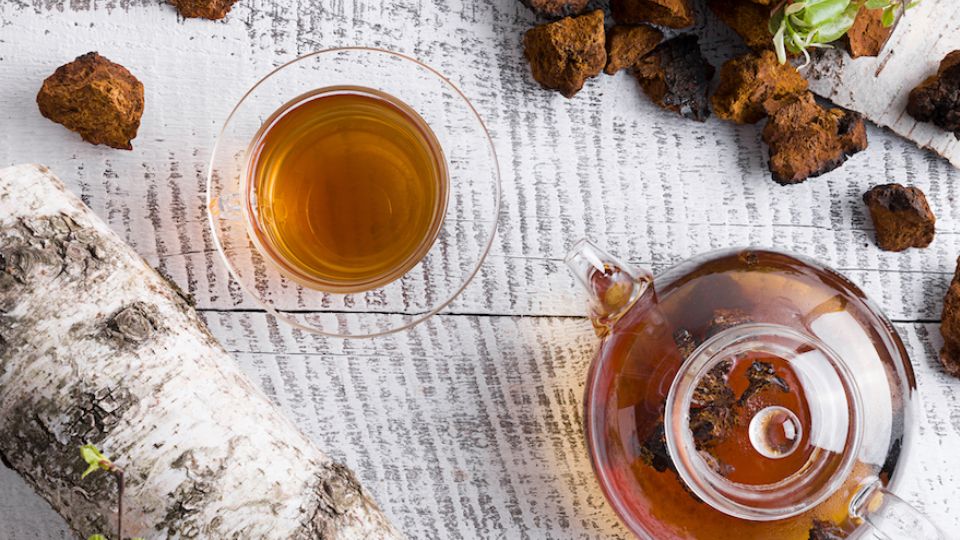
Apart from Chaga tea and mushroom coffee, chaga can be enjoyed in many forms, such as extracts, tinctures, gummies, and powdered supplements. Check out our curated list of the best Chaga supplements we’ve personally tested and reviewed. We’ve thoroughly researched the most popular chaga products available on the market.
The extract is a concentrated form of the mushroom, making it a convenient option for those seeking a potent dose of its health benefits.
It can also be used in an alcohol tincture, providing an alternative method of consumption for those who prefer not to consume it in tea form. Additionally, the mushroom powder can be incorporated into various recipes or blended into smoothies, offering a creative way to integrate this superfood into one’s diet.
If you’re not a fan of the mushroom taste, don’t worry. Chaga gummies are also available as an option. They offer a convenient and delicious way to enjoy the benefits without the earthy flavor. Give them a try and satisfy your sweet tooth while still getting the goodness of chaga.
The Future of Chaga
The future of Chaga holds promise as researchers continue to uncover its potential as a medicinal plant. With ongoing studies, there is hope for a deeper understanding of its therapeutic properties and how it can be harnessed for human health benefits.
Efforts to develop sustainable harvesting practices and preserve the delicate balance of the ecosystem will be critical in ensuring the availability of Chaga for generations to come.
FAQs About The Two Sides of Chaga
Do You Use the Black Part of Chaga?
Yes, you use the black, woody part of Chaga for making tea or extracting its beneficial compounds. This part is rich in antioxidants and nutrients. It’s typically shaved or ground into smaller pieces before use in tea or other preparations to harness its health benefits.
What are The Parts of Chaga?
Chaga consists of three main parts: the black exterior (sclerotium), the brown middle layer (conk), and the yellow interior (mycelium). The black part is the most commonly used and contains beneficial compounds for health purposes.
Can You Consume Too Much Chaga?
Yes, consuming excessive Chaga can lead to digestive discomfort. It’s best to follow the recommended guidelines for Chaga tea or supplements and not overindulge. Always use it in moderation and consult a healthcare professional for personalized advice if you have concerns about Chaga consumption.
How Long Does it Take Chaga to Work?
The time it takes for Chaga to work can vary from person to person. Some may experience benefits shortly after use, while others may take longer. Consistency in consumption and patience are key for noticing potential health effects.
What Are The Disadvantages of Chaga Mushroom?
Potential disadvantages of Chaga mushrooms include allergic reactions, digestive issues, possible interactions with medications (like blood thinners or diabetes drugs), and the risk of lowered blood sugar levels. It’s essential to use chaga responsibly and consult a healthcare professional if needed.
Final Thought on The Two Sides of Chaga
Chaga stands as a fascinating mushroom with two distinct sides – one offering a plethora of potential health benefits and the other raising concerns about overharvesting and ethical practices. As we continue to explore the world of medicinal mushrooms, chaga remains a subject of ongoing research and curiosity.
While the health benefits of chaga are enticing, it is essential to exercise caution and make informed decisions when incorporating it into our daily lives. By supporting responsible harvesting and staying informed about new research findings, we can collectively contribute to the preservation of this remarkable and valuable resource.
References
1. Methanol extract of Inonotus obliquus improves type 2 diabetes mellitus through modifying intestinal flora. Retrieved from https://www.researchgate.net/publication/366922038_Methanol_extract_of_Inonotus_obliquus_improves_type_2_diabetes_mellitus_through_modifying_intestinal_flora
2. Immunomodulatory Activity of the Water Extract from Medicinal Mushroom Inonotus obliquus. Retrieved from https://www.ncbi.nlm.nih.gov/pmc/articles/PMC3774877/
3. Anti-inflammatory and anticancer activities of extracts and compounds from the mushroom Inonotus obliquus. Retrieved from https://www.researchgate.net/publication/236125885_Anti-inflammatory_and_anticancer_activities_of_extracts_and_compounds_from_the_mushroom_Inonotus_obliquus
4. Phytochemistry, traditional uses and health benefits of the mushroom inonotus obliquus (Chaga). Retrieved from https://www.researchgate.net/publication/292243402_Phytochemistry_traditional_uses_and_health_benefits_of_the_mushroom_inonotus_obliquus_Chaga
5. A review of the pharmacological activities and protective effects of Inonotus obliquus triterpenoids in kidney diseases. Retrieved from https://www.researchgate.net/publication/362088057_A_review_of_the_pharmacological_activities_and_protective_effects_of_Inonotus_obliquus_triterpenoids_in_kidney_diseases
6. A review of the pharmacological activities and protective effects of Inonotus obliquus triterpenoids in kidney diseases. Retrieved from https://www.researchgate.net/publication/356655543_Research_of_Inonotus_obliquus_Oligosaccharide_in_Prevention_of_Hyperlipidemia
7. Composition of Triterpenoids in Inonotus obliquus and Their Anti-Proliferative Activity on Cancer Cell Lines. Retrieved from https://www.researchgate.net/publication/344218551_Composition_of_Triterpenoids_in_Inonotus_obliquus_and_Their_Anti-Proliferative_Activity_on_Cancer_Cell_Lines
8. Inonotus obliquus upregulates muscle regeneration and augments function through muscle oxidative metabolism. Retrieved from researchgate.net/publication/368311388_Inonotus_obliquus_upregulates_muscle_regeneration_and_augments_function_through_muscle_oxidative_metabolism
